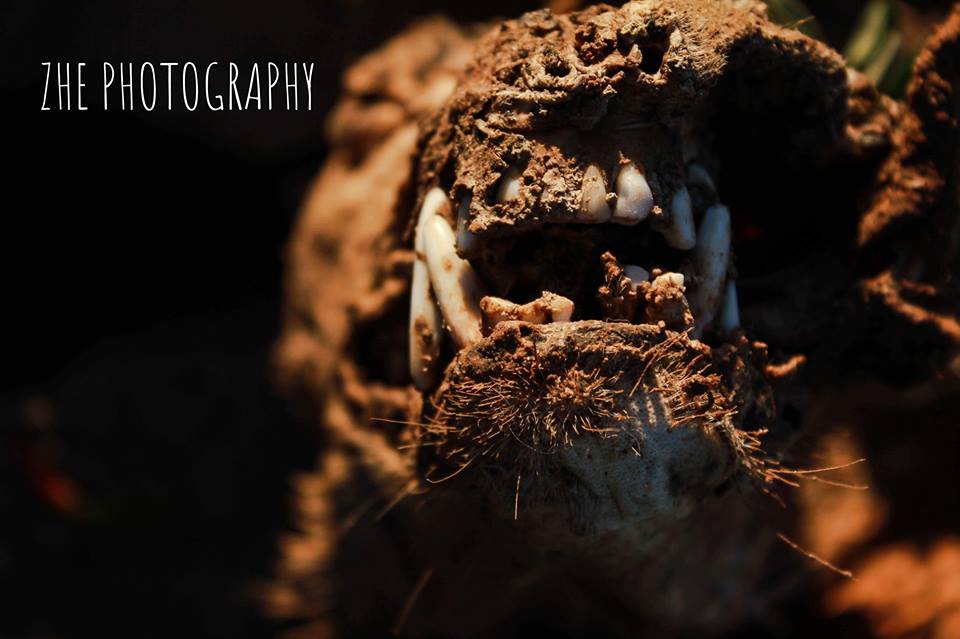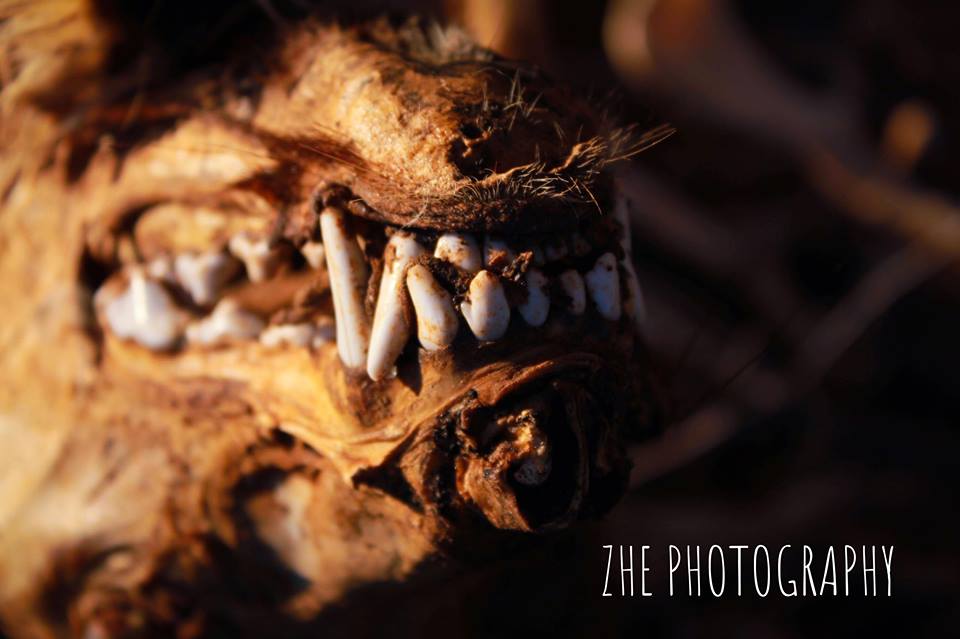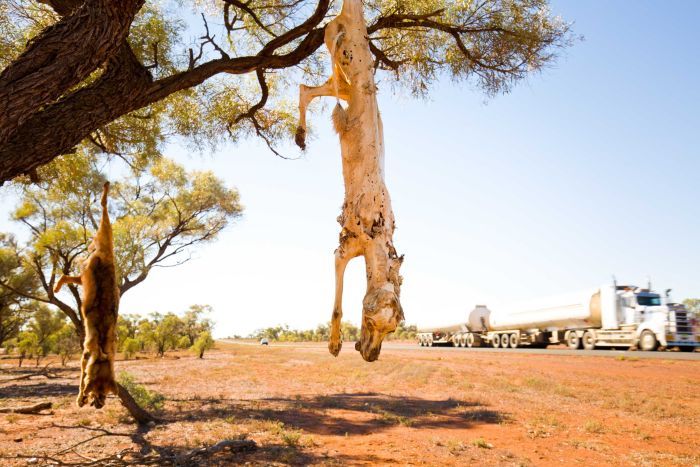Red Dog
Host: Zoe Hayes
Location: North West Queensland
Red dog? Nah mate, dead dog!
Driving along a dirt road past rural properties in Blackall QLD it was a sight & stench for sore eyes, but one I took as a rare photographic opportunity. Wild dogs strung up swinging with the breeze hanging from farmer’s trees. Poetic or what? I captured photos I feel are raw & show a morbid beauty of these wild dogs. I already knew the damage & affect wild dogs have on farmers land & have first hand seen stock shredded apart like a pit-bull let loose on a stuffed toy. So for me although I am extremely passionate about wildlife I know in this industry culling is a must!


But honestly, why the need to hang them from trees? Well I took to Google & found my answer. ABC News journalist Mary Lloyd wrote in September 2017 a very interesting read Dead dogs in trees: what’s that all about?
“Even heading up the highway at speed, it is hard not to notice two dead dogs strung up by their tails from a tree at the roadside.
It is a macabre sight — not to mention a pungent smell when viewed up close from downwind.
And it is a sight meant to be seen.
But exactly why the carcasses are left swinging from the branches is not widely known.
Many people, even those with a strong connection to regional areas, think farmers do it to warn off other dogs.
But Tim, who has shot and trapped wild dogs on a station in the Northern Territory, says that’s not true.
As he sees it, the practice is a form of communication among farmers, or between hunters and farmers.
In the area Tim grew up, the only time some farmers spoke was at a local hall function or when baiting of dogs was about to start, so if there was a pack of dogs about and a farmer shot one, he would hang it up so others knew there was one fewer to deal with.
A worker in charge of vermin control could also use it as a way of demonstrating to the station manager that efforts are underway to control dogs on the property, he said.
On smaller farms, Tim believes it is done to tell other farmers that a problem hound has met its demise.
“There may be five farmers after the one dog and hanging them up allows all five to identify it as the dog they have been chasing,” he said.
Gavin Byrne, who has worked as a ringer, head stockman and manager in south-west and central Queensland, says the carcasses can also be a form a protest by graziers.
In a post on Facebook group Ringers from the Top End, he said stringing dogs up started as a political statement to make people aware of the devastation they cause to livestock and livelihoods, and as a complaint against the lack of action taken by the Government.
“That is why you see them hung on road signs or beside roads,” he said.
Cob Horse has a cattle station west of Blackall and said, on his property, the practice was a simple way of auditing how many dogs staff members have killed.
They pay a bonus for each dog slaughtered, so staff have their own trees where they hang any wild dogs they dispatch.
‘No-one breeds sheep anymore because of dogs’
Wild dogs are more often referred to as dingoes by people who seek to conserve them, and can be either pure native dogs or crossbreeds.
They are considered both native wildlife under the Nature Conservation Act 1992 and restricted invasive animals under the Biosecurity Act 2014.
There are few places in Australia where serious moves are being made to conserve them, and the animals can be shot, poisoned or trapped by pest control officers, property owners and licensed hunters.
Amanda Turlan, who shoots and traps dogs for property owners, said it was just a way of life for people who live in the bush.
She said a lot of properties near where she lives used to farm sheep, but dogs became such a problem no-one breeds sheep anymore.
“They kill them faster than what they can breed,” she said.
‘Very cruel’ dogs mortally wound then abandon animals
The damage dingoes do to stock earns them little love in farming communities, where they are considered vermin and treated as pests.
Ms Turlan described them as very cruel and said they will run down kangaroos until they die of fright, or mortally wound animals then abandon them.
“I’ve seen sheep dying a slow death with missing kidneys from a dog,” she said.
Biologists call it “surplus killing”.
University of New South Wales Associate Professor Mike Letnic says dingoes are known to lethally wound sheep without having any need to kill them, but he does not consider it cruel or unusual.
Associate Professor Letnic says all mammal predators engage in surplus killing — even humans who often hunt and fish more than they need.
When dingoes do it, it can cause enormous losses for farmers, because one animal can kill lots of sheep over a short period.
Dingoes ‘have important role keeping ecosystem healthy’
Dogs in the trees are a way of calling on neighbours and other people in the area to keep up the fight, Associate Professor Letnic said.
His research has showed dingoes play an important role in keeping ecosystems healthy, and that they help to keep down populations of foxes, kangaroos and wild cats — but that is little comfort to farmers.
What he would like to see is a place found where wild dogs can be free to roam wild.
“We need to find places where wild dogs can be dingoes,” he said.
 Photo: Mary Lloyd.
Photo: Mary Lloyd.
You may think wild dogs hanging in trees is an old wives tale that it wards off other dogs but in fact its more so a way of farmers communicating with each other. A cattle station West of Blackall, Queensland uses this practice as a way of auditing how many dogs staff members have killed for their end of year bonus for each dog slaughtered.
“Wild dogs are strung up to inform others that the problem hound has been brought down”
